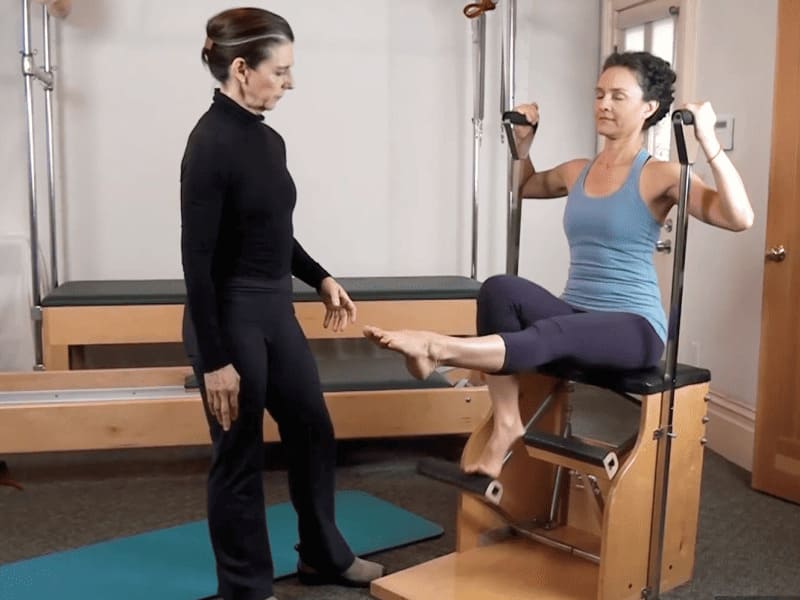Hypermobility is a poorly understood condition, whose medical diagnosis is often missed by traditional imaging techniques, and patterns of recognition diagnosis. Hypermobility can mean several things. It is the wise movement educator who learns to distinguish what is considered hypermobile, and its level of severity. The hyper-mobile population includes clients who are either post-partum, have acquired their flexibility through physical training or trauma, have an autoimmune issue or have a genetically loose collagen type. In addition, their joints may be shaped differently than our general client population.
Pre-activation of fascial lines gives stability to movement. Learn how to assess the levels of severity of hypermobility to build confidence for you and your client. Learn strategies of pre-activation through not only core but also the spine and extremities. Come away with a new understanding of how the pre-activation in not only mat work but on the Reformer and Chair will help your client successfully participate in Pilates without injury. All active people can use this course.
Contraindications and precautions will be addressed for this population. Course content reviews structural assessment and targets the most effective sites of concentration for optimal stabilization to restore optimal function and greatest discomfort relief. Specific exercises will be presented along with a home-exercise program.
Objectives
Upon completion of this course participants will be able to:
- Describe the term hypermobility.
- Describe the classifications of the spectrum of hypermobility.
- Better understand the different populations who may be affected by hypermobility and why
- Better understand the difference between acquired hypermobility and genetic hypermobility
- Describe the body’s local tissues reactions to hypermobile joints
- Better understand the difference between instability and hypermobility
- Better understand the difference between those with a disease state and those with a hypermobile condition
- Better understand the elements involved with helping those with hypermobility to exercise safely
- Describe how movement environments can help those with hypermobility
- List and identify the criteria for the revised Brighton hypermobility scale
- Describe evidence that gives information about how to help and train those with hypermobility
- Describe goals useful in working with a hypermobile population
- Learn both mat and Pilates exercise series that focus on the following body areas to promote better joint congruency and ergonomics for exercise and for daily life
- Spine
- Hips
- Knee and leg alignment
- Ankles and feet
- Elbows and wrists
- Neck
- Describe how the activation of fascia promotes joint stability and potentiates strength
- Learn strategies to coordinate fascial continuities of the deep frontal line with the arm lines, superficial back, lateral lines, and spiral lines
- Learn applications of fascial pre-activation and tensioning on the Pilates reformer, coordinating the deep frontal line with the arm lines, lateral lines, and spiral lines.
Who Should Take this Course?
This course is intended for licensed Physical Therapists, Physical Therapy assistants, Certified Pilates Instructors, Fitness Instructors, Yoga Instructors, Nurses, and Physicians
Lesson Plans
Hypermobility Lecture 1
- Describe the term hypermobility, the varying types of hypermobility and their impact on the client in the Pilates environment
- Describe the mascot Zebra, and the updated 2017 International Ehlers-Danlos Society classifications
- Describe evidence that gives information about how to help and train those with hypermobility, plus how and when to refer to medical providers for further attention
- Explain populations who may be affected by hypermobility and why
- Explain Difference between acquired and genetic hypermobility
- Explain the body’s local tissues’ reactions to hypermobile joints
- Better understand the difference between instability and hypermobility
- Assessments and Outcome measures
- Characteristics of motor control
- Learn and identify the criteria for the revised Brighton hypermobility scale; characteristics- observation assessments
- Explain how the Pilates environment can help those with hypermobility
- Describe appropriate mechanics, cues, and images for the use of arms, hands, neck, feet, knees, and hips on the Pilates Apparatus
- Take home Message: Describe and define goals useful in working with a hypermobile population
- Demonstrations in the Pilates Environment for Hypermobility
Working with Hypermobile Clients in a Pilates Environment
Hypermobility Lab 1
Review pertinent anatomy faults common in clients with hypermobility for the body regions affecting:
- Knee and leg alignment
- Ankles and feet motions
- Elbows and wrists
Learn exercise series in the Pilates environment that focus on the following body areas to promote better joint congruency and ergonomics in the Pilates environment as well as in daily life
- Knee and leg alignment: frame and shape fascia of joints
- Ankles and feet: frame and shape fascia of joints
- Elbows and wrists: frame and shape fascia of joints
Hypermobility Lab 2
- Imagery of Tensional Organization MAT
- Cup/suck/rotator cuff-hips and shoulders
- Smile/Frown for Deep Fascial Tension
- Vitruvian Man
- Preparing fascia for optimal engagement
- Framing the client for success of motion
- Pre-activation of fascial continuities
- Experience fascial sling connections to promote functional gait through Transformational Gait
- Hypermobility and the Pilates Environment: Reformer, Trapeze, Pedal Chair, MOTR


